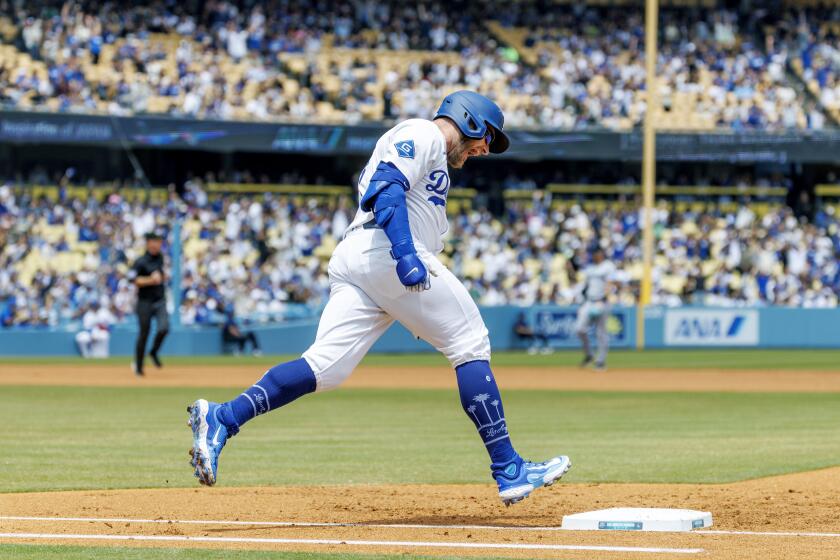Stan Kasten says don’t expect a blockbuster as Dodgers seek help
- Share via
Dodgers Chairman Mark Walter declared this week that his team’s baseball operations department wouldn’t be under any budget restrictions leading up to the July 31 nonwaiver trade deadline.
To fans desperate for a blockbuster trade after seeing their team lose 19 of its last 26 games, that was hopeful news.
However, in the wake of Walter’s remarks, team President Stan Kasten would like to clarify a couple of things.
Any trade, he said, would “have to be governed by reason” and “make sense long term.”
Building the kind of “great team” Walter envisions “probably can’t be done overnight,” Kasten warned.
In other words, don’t expect the Dodgers to land a player of Manny Ramirez’s stature, as they did at the 2008 deadline when the Boston Red Sox practically handed the disgruntled slugger over for free.
Dodgers General Manager Ned Colletti would like to bolster the club by adding a starting pitcher, a hitter to complement Matt Kemp and Andre Ethier, and a left-handed reliever.
Trade talk has intensified over the last few days, according to people familiar with their operations. Chicago Cubs right-hander Ryan Dempster, who leads the National League with a 1.86 earned-run average, remains a primary target.
Dempster is 35 and will be a free agent at the end of the season.
Philadelphia Phillies shortstop Jimmy Rollins is 33 and won’t be, which explains the Dodgers’ apparent lack of interest in him.
A former National League most valuable player, Rollins is hitting .258 with nine home runs and 34 runs batted in. With Dodgers shortstops batting a combined .232 with two home runs and 22 RBIs, Rollins would be an immediate upgrade over the likes of Dee Gordon and Luis Cruz.
But Rollins is under contract and owed $11 million the next two seasons — three if he reaches performance benchmarks to guarantee an $11-million option for 2015. And he’s slowing down. The last time he scored 100 runs was three seasons ago. The Dodgers don’t view him as a long-term solution at shortstop, something they think the 24-year-old Gordon could still be.
The Dodgers would take on a multiyear contract for the right player. The problem is, such players are rarely available.
For example, Chase Headley of the San Diego Padres would be an upgrade at third base. But because Headley is under contract for a relatively modest $3.475 million this year and won’t be eligible for free agency until after the 2014 season, the Padres are asking for multiple top prospects in return. That’s a substantial price for a player who was batting .268 entering Thursday.
Though the Dodgers’ farm system has produced several major league players in recent seasons, it is currently short on top-tier talent because spending on amateur players was curbed during Frank McCourt’s ownership.
Parting with top prospects to obtain Headley could leave the Dodgers short in filling another vital need — pitching.
The Phillies are said to be preparing to offer left-hander Cole Hamels a long-term contract extension, but if he becomes available via a trade, it would probably require a package of prospects to get him.
“At this time of year, people tend to value prospects more than cash,” Kasten said.
In other words, having money to spend might only take the Dodgers so far in trade discussions.
And the same could be said about the off-season.
With more teams signing top players to long-term contracts before they become free agents — as the Dodgers did with Kemp and Ethier — the free-agent market isn’t as talent-rich as it used to be.
The top position player who figures to be available this winter is Josh Hamilton, but the Dodgers might be hesitant to bring a player with Hamilton’s history of substance abuse to Los Angeles.
Kasten said if the Dodgers can’t acquire top players via free agency, they will have to find other ways to do so. He believes that’s possible.
“That stuff tends to find its balance,” he said. “You go to the winter meetings in years it’s been hot for free agency, trades are held back. If there are no free agents, there are more trades.”
As he often does, Kasten recalled his days as president of the Atlanta Braves. He pointed specifically to the Braves’ rotation, which included Greg Maddux, Tom Glavine and John Smoltz.
A different method was used to acquire each of the three Cy Young Award winners.
Maddux was signed as a free agent before the 1993 season. Glavine was drafted out of high school in 1984. Smoltz was acquired in a trade in 1987.
“You have to use all the tools,” Kasten said.
More to Read
Go beyond the scoreboard
Get the latest on L.A.'s teams in the daily Sports Report newsletter.
You may occasionally receive promotional content from the Los Angeles Times.










